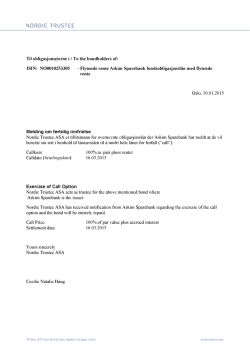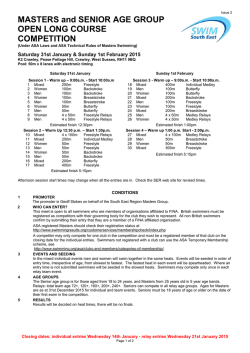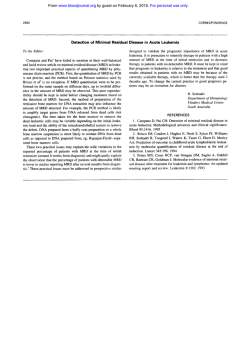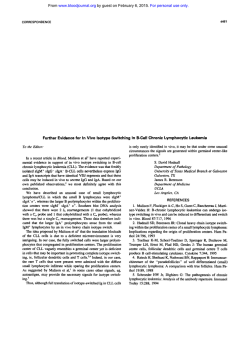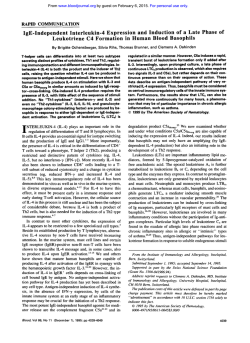
Purification and Characterization of a C5a-Inactivating
From www.bloodjournal.org by guest on February 6, 2015. For personal use only. Purification and Characterization of a C5a-Inactivating Enzyme From Human Peritoneal Fluid By Suhail K. Ayesh, Yehudith Azar, lyad I. Barghouti, Julie M. Ruedi, Bernard M. Babior, and Yaacov Matzner than the crude material. On Westernblot, an inhibitory antiEarlier work has suggested that familial Mediterranean feat thesame mover, aninherited disorder characterized by sporadic episodes body recognized a single antigenic species lecular weight. The enzyme had no activity against denaof inflammation involvingthe pleural and peritoneal cavities tured bovineserumalbumin. With recombinant C5aas and the joints, is caused by the lackof a C5a inactivator substrate, the K,, and V,,, were 3.4 pmol/L and 52 nmol C5al normally found in serosal fluid.We have purified this inactimin/mg protein, respectively. vator from ascites fluid and obtained a protein of molecular 0 1995 by The American Societyof Hematology. weight 53 to 56 kD with a specificactivity 10,000-fold greater Ascites fluid was heated at 56°C to inactivate complement; EUTROPHILS ARE initially attracted to a site of in(NH&S04 precipitates were dissolved in 10 mmoUL Tris . HC1 flammation by chemotactic factors, released firstby the causative agent (eg, invading microorganisms) and then by the(pH 7.4) at an Azsoof 6.6 and then desalted by dialysis against neutrophils themselves. A major chemotactic factor produced the same buffer. The C5a-inactivating enzyme in the samples was determined by measuring the chemotaxis of fresh human neutrophils during inflammation is the complement fragmentC5a, which as previously de~cribed,~ using a mixture of 10% (voYvol) sample is released not only through complement activation but also and either 1% (voVvol) zymosan-activated serum or 1 nrnoVL rC5a through the actionof a protease released from neutrophil spe- as chemoattractant. Random migration was determined by measuring cific granules.’.’ C5a-md1ated chemotaxis is thus a self-ammigration toward phosphate-buffered saline (PBS)/0.6% BSA/O.l% plifying process in which low concentrations of C5a attract glucose. Chemotaxis was calculated by subtracting random migraneutrophils to sites of inflammation, where higher local C5a tion from the distance traveled toward rC5a. concentrationsprovoke the releaseof the CS-splittingenzyme Myeloperoxidase release. C5a-induced myeloperoxidase release from neutrophils’ was used tolocate the C5a-inactivating enzyme in from the neutrophil-specific granules, resultingin the produccolumn fractions. Fifty microliters of 10 nmoUL rC5a in suspending tion of more C5a that attracts and activates more neutrophils. buffer (Hank’s Balanced Salt Solution [HBSS] containing 25 mmoU Because of self-amplification, the accidental release of even L HEPES [pH 7.41 and 0.25% BSA) and an equal volume of the minimal amounts of C5a could cause an inappropriate fullfraction to be assayed were loaded in triplicate into wells in a 96scale inflammatoryresponse,unless some countervailing well microtiter plate. The plate also contained a negative control mechanism existed to prevent such an occurrence. consisting of 50 p L of suspending buffer plus 50 pL of column In seeking such a countervailing mechanism, we discoveluting buffer and a positive control containing 5 nmolL rC5a in ered a diisopropyl fluorophosphate (Dm)-inhibitable enthe same buffer mixture used for the negative control. The plate was zyme in serosal fluids that neutralizes C5a, possibly by limincubated at 37°C for the indicated period of time (usually 30 minited The activity of this C5a inactivating utes). Twenty-five microliters of neutrophil suspension (4 X 10’ enzyme was greatly reduced in serosal fluids from patients celldmL in suspending buffer) that had been incubated for 10 minwith familial Mediterranean fever (FMF), an inherited disutes at37°Cwith 5 pg/mL cytochalasin B (added from a stock ease characterized by episodes of unprovoked inflammation solution containing 1 mg cytochalasin B/mL in dimethylsulfoxide) were added to each well, and degranulation was allowed to proceed involving serosal spaces.6-sThese findings suggested that the for 10 minutes at 37°C. Myeloperoxidase release was then measured C5a-inactivating enzyme functions to prevent inappropriate by adding to each well 50 pL sodium phosphate buffer, pH 6.8, inflammation in serosal tissues and that its deficiency may followed by 25 pL of o-phenylenediamine/H,Ozsolution (see below) explain the attacks of inflammation characteristic of FMF. and incubating for 5 to 20 minutes at room temperature, determining In this report, we describe the purification of this enzyme the incubation time by watching the color development in the posifrom ascites fluid. N tive control well. When the color in the positive control well had MATERIALS AND METHODS Materials Recombinant C5a (rCSa), cytochalasin B, o-phenylenediamine, goat antirabbit IgG conjugated to alkaline phosphatase, p-nitroblue tetrazolium . HCI, 5-bromo-4-chloro-3-indolyl phosphate, benzamidine, Blue Sepharose CL-6B, and arginine agarose were purchased from Sigma (St Louis, MO). The rC5a was dissolved in distilled water containing bovine serum albumin (BSA) at 2.5 mg/mL. [‘Z51]albumin (2.7 pCi/pg) was obtained from Amersham (Arlington Heights, IL). Freund’s adjuvants were from Difco Lab (Detroit, MI). Diethyl aminoethyl (DEAE) cellulose (DE-52) was obtained from Whatman Biosystems (Maidstone, Kent, UK), Sephadex (3-10 and G-l00 from Pharmacia (Uppsala, Sweden), and nitrocellulose membranes from Schleicher and Schuell (Germany). All other chemicals were of reagent grade and were purchased from Sigma. Methods Assays of the CSa Inactivating Enzyme Neutrophil chemotaxis. Chemotaxis was used to measure the C5a-inactivating enzyme in ascites fluid and (NH4)2S04precipitates. Blood, Vol 85,No 12 (June 15). 1995: pp 3503-3509 From the Hematology Unit, Hadassah University Hospital, Mount Scopus, Jerusalem, Israel; and the Department of Molecular and Experimental Medicine, The Scripps Research Institute, La Jolla, CA. Submitted November 8, 1994; accepted January 25, 1995. Supported in part by Grant No. 89-00217from the United StatesIsrael Binational Science Foundation, US Public Health Services Grant No. AI-24227, a grant from the Kovshar Foundation, and a Wolfson Research Award administered by the Israel Academy of Sciences and Humanities. Address reprint requests to Yaacov Matzner, MD, Hematology Unit, Hadassah University Hospital, Mount Scopus, Jerusalem, Israel 91240. The publication costs of this article were defrayed in part by page charge payment. This article must therefore be hereby marked “advertisement” in accordance with 18 U.S.C. section 1734 sole1.y to indicate this fact. 0 1995 by The American Society of Hematology. 0006-4971/95/8512-0029$3.00/0 3503 From www.bloodjournal.org by guest on February 6, 2015. For personal use only. 3504 AYESH ET AL .................................................. the marker were pooled and used as the proteolysis substrate. To measure proteolysis, inactivator at the concentrations indicated was added to 3.5 nmol of protein (C5a or denatured ['2sI]albumin)in 0.5 mL of PBS. Duplicate incubations were performed for 15 minutes at 37°C. Loss of C5a activity was measured by the myeloperoxidase assay. Proteolysis of albumin was measured by sodium dodecyl sulfate-polyacrylamide gel electrophoresis (SDS-PAGE)/autoradiography and by the release of trichloroacetic acid-soluble counts. SDS-PAGE was performed on 20-pL portions of the reaction mixtures using a 10% gel, and radioactive bands were detected by exposing the gel to Agfa XP 18/24 film (Curix, Mortsel. Belgium). C5a only lnactkvator only ~.~~*~~~~~.~.~...~....~.......~.~..~......~*..~..~.~-...~~.~..~~. &.I....... 0 4 8 12 16 T~me(mm) Fig1. Spectrophotometric determination ofC5a inactivation by the purified C5a inactivator. Incubations were performed as described in Materials and Methods, with omissions asnoted. The concentrations of C5a and inactivator used in these experiments were 0.72 pmoilL and 3.5 pglmL (0.066 pmollL. assuming a molecular weight of 53 kD [see text]), respectively. Absorbances at zero time were set arbitrarily; their absolute values were 0.337 for C5a only, 0.137 for inactivator only, and 0.148 for both. Preparation of Polyclonal Antibody Against the C5a Inhibitor Rabbits were immunized with 100 to 200 pg ofpurified C5a inactivator in 1 mL of complete Freund's adjuvant (0.25 mL in each footpad). The animals were boosted 2 weeks later byan identical procedure and then three more times by subcutaneous injections of 100 to 200 pg of C5a inactivator in 1 mL of incomplete Freund's adjuvant. Serum was collected 3 weeks after the last injection, decomplemented by heating at 56°C for 30 minutes, and then assayed for activity against the C5a inactivator using the chemotaxis and the myeloperoxidase methods. Gel Electrophoresis and Western Blotting reached a satisfactory intensity, the reactions were stopped with 3 N HCl and A,,, was read in a microtiter plate reader. In conducting this assay, particular attention hadtobepaid to two points. First, neutrophil quality had to be optimum; the cells had to beas fresh as possible and completely free of clumps. Second, the o-phenylenediamine/H,02 solution had to be prepared just before use by dissolving a 10-mg o-phenylenediamine pill (Sigma) in 2.5 mL citrate-phosphate buffer (25.7 mL 0.2 mom NaZHPO, + 24.3 mL 0.1 m o m citric acid + 50 mL distilled water) and then adding to this solution 7.5 pL 30% HzOz (Sigma). Any delay between the preparation of the o-diphenyleneamine/H20z solution and its use resulted in an unsatisfactory assay. Results were corrected for myeloperoxidase release in the absence of rC5a. Spectrophotometry. The inactivation of C5a by the C5a inactivator could be followed spectrophotometrically at 254 nm. Reaction mixtures containing various concentrations of rC5a together with 0.2-mL portions of purified inactivator in 1 mL of 10 mmol/L Tris * HC1,pH 7.4, were incubated at room temperature in a recording spectrophotometer. Rates were calculated from the differences in absorbance at 1 and 5 minutes. Figure 1 shows that a loss in absorbance of 0.01 U corresponds to the inactivation of 0.72 nmol C5dmL reaction volume. Loss of absorbance was not observed in incubations containing C5a alone, purified C5a inactivator alone, or a mixture of C5a and the inactivator together with 1 mmom phenylmethylsulfonyl fluoride (PMSF; PMSF experiment not shown). The spectrophotometric results were confirmed by chemotaxis measurements, which showed that no chemotactic activity remained after 15 minutes of incubation. Nonspecific Proteolysis Nonspecific proteolysis was determined by comparing C5a inactivation with the hydrolysis of denatured ['LSI]albuminunder identical experimental conditions. For denaturation, 25 pL of ['2sI]albumin (0.4 pg/pL) was incubated with 200 pL of 4 m o m guanidine . HCV50mmoVL dithiothreitol for 5 minutes. Cyanocobalamin was added as marker and the mixture was desalted over a 10-mL Sephadex G-25 column equilibrated with PBS, eluting with PBS, and collecting 0.5-mL fractions. "'I-containing fractions eluting before SDS-PAGE was performed by the method of Laemmli"' using 12% running gels. The gels were stained with either Coomassie Blue or silver stain. Nondenaturing PAGE was performed under the same conditions except for the omission of SDS and dithiothreitol. For Western blotting, the proteins were transferred electrophoretically to a nitrocellulose membrane that was blocked for 2 hours at room temperature with PBS/5% BSA andthen incubated for 1 hourat room temperature with a 1:lOO dilution of the rabbit antiserum. Bands were visualized with goat antirabbit IgG conjugated to alkaline phosphatase followed by treatment with a solution containing p-nitroblue tetrazolium HCl (0.33 mg/mL) and 5-bromo-4-chloro3-indolyl phosphate (0.165 mg/mL)." RESULTS Purification of the C5a-Inactivating Enzyme Some ascites fluids from patients with benign hepatic cirrhosis were found to contain the C5a inactivator at the concentration previously found in normal peritoneal fl~ids.~.'.' Because ascites can be obtained in liter amounts, we used this fluid as the source of the inactivator for purposes of purification. Ascites was obtainedfrom patients with alcoholicor posthepatic cirrhosis of the liver and assayed to make sure the inactivator was present in the material (the inactivator tended to be absent from ascites obtained from patients with hepatitis B or malignant ascites). Ascites that contained the inactivatorwascentrifuged (1,500g for 10 minutes at4°C)to remove cells and debris and then divided into50-mL aliquots andstoredat -20°C untiluse. The purificationwasperformed at 4°C. The C5a inactivator was precipitated from50 mL of peritonealfluidbybringingthefluidto 35% saturationwith (NH4)?S04. After 4 hours,themixturewascentrifuged (15,OOOg for 20 minutes) and the supernatant was discarded. The pellet was suspended in 5 mL of 0.01 m o m Tris-HC1 (pH 7.4) and desalted over a Sephadex G-l0 column (2.4 X From www.bloodjournal.org by guest on February 6, 2015. For personal use only. 3505 C~A-INACTIVATINGENZYME Table 1. Purification of the Serosal Fluid C5a lnactivator Total Protein 7 5 9 l1 13 15 l? Peritoneal fluid Ammonium sulfate precipitation 2300 100 0.00003 800 110 0.00009 104 3 18 0.00054 86 88 67 37 333 7 9,990 IS 2.50 100 2.00 80 1S O 60 1.oo 40 0.50 20 5 10 15 25 20 30 35 0 40 Fraction Number 0.04 0.03 0.02 0.01 0.00 2 3 4 5 6 7 8 55 4.6 0.016 0.3 (fold) 1 The experiments were performed as described in the text. All assay mixtures contained 3.3 nmol/LC5a except the assay mixture used with crude peritoneal fluid, which contained 1 nmol/L C5a. Because these assays were performed using C5a concentrations far below the K, of the enzyme, the specific activities are expressed as nmol C5a/ min/mg inactivator/nmol/L C5a. Fraction number 0.00 Purification (mg) Affinity chromatography 3 Yield (96) Purification Step DE-52 Blue Sepharose 0.0011 0.01 Sephadex G-100 1 Specific Activity (nrnol CBa/rnin/rng inactivator/ nrnol/L C5a) 9 1 0 1 1 1 2 Fraction Number Fig 2. Column chromatography ofthe C5a inactivator. This figure shows the results from a representative purification. C5a activity was measured as inhibition of rC5a-induced release of myeloperoxidase from neutrophils as describedin Materials and Methods. IO) Inhibition of myeloperoxidase release;(01, protein concentration l&m). (A) DEAE-wllulose. & in the control incubationwas 0.92. Fractions 14 through 18 were pooled for further purification. (1) Start of elution with 0.25 mollL NaCI. (B) Sephadex 6-100. & in the control incubation was 0.65. Fractions26 through 32 were pooled for further purification. IC) L-arginine agarose.& in the control incubationwas 0.65. Fractions 8 through 11 were pooled and concentrated for further analysis. 25 cm) equilibrated with the same buffer. Fractions containing the C5a inactivator were then pooled and applied to a DEAE-cellulose column (DE-52, 3 X 6 cm) equilibrated with 0.01 m o m Tris-HC1 (pH 7.4). The active material was eluted with 0.25 m o m NaCl in the same buffer, collecting 5-mL fractions (Fig 2A). Fractions containing inhibitory activity were pooled, desalted over Sephadex G-10, adjusted to a final buffer composition of 0.05 m o m Tris HCl (pH 7.0)/0.1 m o m KCl, and applied to a Blue Sepharose CL6B column (1.6 X 10 cm) equilibrated with the same buffer, eluting with the same buffer at 0.7 ml/min. The C5a inactivator eluted with the pass-through. Fractions containing the C5a inactivator were pooled, concentrated to 4 mL by ultrafiltration with a PM-l0 membrane (Amicon Corp, Lexington, MA), and applied to a Sephadex G-l00 column (1.5 X 48 cm) equilibrated with 0.04 m o m Tris * HCl (pH 7.4). The column was eluted at 0.3 mL/minwiththe same buffer, collecting 3-mL fractions (Fig 2B). The active fractions* were analyzed by SDS-PAGE, and those with the fewest protein bands were pooled. The pooled active fractions were applied to an L-arginine agarose affinity column (1.2 X 22 cm) equilibrated with 0.04 m o m Tris HCl (pH 8.5). The inhibitor activity was eluted at 0.45 mL/min with the same buffer containing 0.2 m o m NaCl, and the fractions (3 mL each) with the highest specific activity were pooled (Fig 2C). For SDS-PAGE analysis, the purified inactivator was concentrated using a Speedvac concentrator (SVC 100H; Savant, Fanningdale, NY). The purification is summarized in Table 1. * C5a activity was also inhibited by certain high molecular weight fractions, suggesting either that some of the CSa-inactivating protease was associated with one or more high molecular weight proteins or that the preparation applied to the G-l00 column contained one or more additional C5a antagonists. Selection of the low molecular weight fractions from the G100 column was based on earlier gel filtration studies showing that themolecular weight of the C5a inactivator of interest was 25 to 40 k D . 3 , 4 From www.bloodjournal.org by guest on February 6, 2015. For personal use only. AYESH ET AL 3506 B A A ..-., B CY. I. y" T" 67 43 I Arginine Column Gel Filtration Fig 3. SDS-PAGE of pooled Sephadex G-l00 fractions that were applied to theL-arginine agarose column (left)and pooled fractions from the L-arginine agarose column (the purified enzyme; right). Samples from thepooled fractions weresubjected t o SDS-PAGE as described in Materials andMethods. Lane A, stained with Coomassie Blue; lane B, immunoblot using anti-C5a inactivator antiserum (see Materials and Methods). BSA (molecular weight, 67 kD) and ovalbumin (molecular weight, 43 kD) were used as standards. Characterization of the C5a lnactivator About 3 pg of pure CSa inactivator were obtained from SO mL of ascites. SDS-PAGE of this materialshowed a single major band at a molecular weight of S3 to 56 kD (Fig 3 right, lane A). The affinity-purifiedenzyme was essentially free of the impurities present in the material applied to the affinity column (Fig 3 left, lane A). On immunoblots of both the preaffinity andpostaffinity column material, an inhibitory antibody raised to the purified CSa inactivator (see below) recognized the inactivator as a 53- to 56-kD antigen (Fig 3, lanes B). In earlier work, the CSa inactivator was found toinactivate CSabutnot the chemotactic peptide F-met-leu-phe.' Later work showed that CSa inactivated by partially purified CSa inactivator ranon SDS-PAGE slightly morerapidlythan C%.' Figure 4 shows that the same product was generated by the pure enzyme.' In addition, pure CSa inactivator, like the partially purified inactivator.' was inactivated by PMSF and inhibited by benzamidine, but was only slightly affected by pepstatin (Table 2). Taken together, these findings support the ideathat the CSa inactivator is a serine protease that performs limited proteolysis on a well-defined group of substrates, although the possibility that it inactivates chemotactic peptides by catalyzing some other reaction involving an amide bond (eg, hydrolysis of a glutamine or asparagine to the corresponding acid or rearrangement of the peptide backbone) cannot be ruled out. To date, the group of substrates for the inactivator has been found to consist of two chemotactic peptides: CSa, released by complement activation. and interleukin-8,'' a polypeptide produced by cells in response to inflammatory cytokines."." The specificity of the CSa inactivator was further examined usingdenatured ['"I]albumin. Whereas trypsin wasable to degrade the labelled albumin to peptides (Fig S ; the aggregated material at the top of the gel was particularly susceptible totryptic digestion), the CSa inactivator could do neither, even though it completely inactivated a similar (in molar terms) quantity of CSa under the experimental conditions (Lw in the myeloperoxidase assay was 0.324 for the starting material, 0.106 for the inactivated CSa, and 0.138 for the CSa-free blank). The results therefore confirm that the CSainactivating enzyme is not a general protease. An antiserum wasraised in rabbits against the purified CSa inactivator. This antiserum recognized the 53- to 56-kD . m Fig 4. Change in the electrophoretic mobility of rC5aafter treatment with C5a inactivator. Incubationmixturescontained 1.25 p g rC5a in 50 p L of 10 mmol/L Tris HCI, pH 7.4, with1 p g of purified out (left) or with C5a inactivator (right).Reactions were performed for 4 hours at 37°C. Samples werethen analyzed by SDS-PAGE on a 20% gel, visualizing with silver stain. The arrowhead indicates the position of the14.5-kD marker. . From www.bloodjournal.org by guest on February 6, 2015. For personal use only. C5A-INACTIVATINGENZYME 3507 Table 2. Effect of Protease Inhibitors on theC5a lnactivator Concentration Protease -2.7 Serine2.0 Aspartyl Inhibitor lmmol/L) PMSF Benzamidine Pepstatin 89.5 Residual Activity of C5a Inactivator (%) 5 1.2 0.8 t 13.8 t 6.1 1.o 0.05 Protease inhibitors at the concentrations indicated were added to 30-pL portions of purifiedC5a inactivator (0.66 nmol/L). The mixtures were then incubated with 1 nmol/L rC5a (final volume, 300 pL) for 10 minutes at 37°C. Chemotaxis was then measured as described in Materials and Methods. At the concentrations used, the inhibitorshad no effect on chemotaxis. Other protease inhibitors (EDTA, dimercaptopropanol, N-ethylmaleimide, and N-tosyl-L-phenylalanine chloromethyl ketone) could notbe examined because of interference with chemotaxis. Chemotaxis was calculated as the distance travelled in response to rC5a minus random migration of48.0 2 3.2 pm. Chemotaxis in response to rC5a in the absence of the C5a inactivator was 39.1 t 0.7 pm. Results are expressed as the mean t SE of three experiments. m 0 'ij In 40 .-> % L c 20 0 750 250 500 1000 Antibody dilution Fig 6. Neutralization of C5a inactivator activity by an antiserum raised against the inactivator.The antiserum wasprepared and heatinactivated as described in Materials andMethods. Its abilityt o neutralize the C5a inactivator was evaluated as follows. Twenty-fivemicroliter portions of heat-inactivated ascites fluid were incubated for 30 minutes with25 pL of heat-inactivated anti-inactivatorantiserum or normal rabbitserum at the dilutionsindicated. The mixtures were then incubated with 5 nmol/L rC5a, and myeloperoxidase renonimlease was measured as described. ( 0 ) Immune serum; (0) mune serum. band on a Western blot of partially purified C5a inactivator (Fig 3). whereas normalrabbit serum recognized nothing. The antiserum did not recognize the protein on a Western blot of unfractionated peritoneal fluid, presumably because the amount wastoolow to be detected. However, it did inhibit C5a inactivation by such fluids, whereas normal rabbit serum had little effect (Fig 6). Treatmentof normal peritoneal fluids with the antiserum reduced C5a inactivator activity to the levels found in peritoneal fluids from patients with FMF (Table 3). Table 3. Inhibition of rC5a-Induced Neutrophil Chemotaxis by Various Peritoneal Fluids 0 172 86 43 pmol enzyme 66 21 Fig 5. Digestion of denatured['"llalbumin by theC5a inactivator and by trypsin. The experiment was conducted as described in the text. The identities and concentrations of the enzymes used in the various reaction mixtures are indicated in the figure. Inhibition of Chemotaxis 1%) Peritoneal Fluid N None Normal, untreated Normal, nonimmune serum-treated Normal, antiserum-treated FMF 7 8 41.5 t 3.8 24.153.5 2 6.5 0 3 3 7 24.1 2 4.2 46.1 t 2.0 39.4 t 10.6 53.5 2 4.6 -12.7 2 6.7 5.0 t 6.8 Chemotaxis (pm) 2 7.4 Chemotaxis was measured as described in Materials and Methods, using as chemoattractant 1% (vol/vol) zymosan-activated serum in the presence and absence of 10% (vol/vol) of the fluid to be studied. The mixture was preincubated for 10 minutes at 37°C before addition to the Boyden chamber. These conditions were chosen to achieve intermediate levels of C5a inactivation. The antiserum and the nonimmune normal serum were heat-inactivated (56°C for 30 minutes), diluted 1:lOO with PES, and then incubated with an equal volume of the peritoneal fluid for 30 minutes at 37°C before the chemotaxis assay was performed. Random migration was 35.0 t 3.2 pm. Results are expressed as the mean 2 SE. N indicates the number of experiments, each using a different heat-inactivated peritoneal fluid. From www.bloodjournal.org by guest on February 6, 2015. For personal use only. 3508 AYESH ET AL The kinetic behavior of the C5a inactivator was evaluated by the spectrophotometric assay, which allowed measurements to be made of initial rates of C5a inactivation. By this method, C5a inactivation was proportional to the inactivator concentration (Fig 7). The purified inactivator obeyed saturation kinetics as the concentration of C5a was varied (Fig 8), showing K,,, values for C5a of 3.6 and 3.2 ymol/L and V,,,,, values at 25°C of 60 and 46 nmol CSa/min/mg protein, respectively, in two separate experiments. 0'30 3 DISCUSSION In defining the physiologic function of the C5ainactivator, its substrate specificity is a key consideration. Earlier experiments showed that even after inactivation by this enzyme, C5a wasrecognized by a polyclonal anti-C5a antibody.' This finding plus others discussed above strongly suggested that the range of substrates for this inactivator was narrow. Our experiments with[1251]albumin provide additional support for this idea andfurther suggest that the activity of the inactivator maybe limited to C5a and possibly to a few other proteins containing sequences related to the sequence around the C5a cleavage site. The C5a inactivator described here was found to be deficient in serosal fluids of patients with FMF, a disorder characterized by inappropriate attacks of inflammation.The clinical features of FMF suggest that the function of the CSa inactivator is to prevent the development of unprovoked inflammatory reactions by counteracting the effects of small amounts of C5a that may be accidentally released into the serosal At its concentration in peritoneal fluid (=S pg/mL, based on the peritoneal fluid protein concentration and the degree of purification neededto obtain homogeneous enzyme from unfractionated peritoneal fluid), the CSa inactivator will inactivate C5a released by such an accident with a half-time of about 2 minutes at25°C (and probably an even shorter half-time at 37"C), a rate that would appear to be fast enough to prevent the C5a from provoking a full- ? -2 0 2 4 llC5e 6 8 10 (PM.') Fig 8. Michaelis constant for the inactivation of rC5a by the C5a inactivator. Reaction mixtures contained 3.5 p g (66pmol) C5a inactivator and rC5a at theconcentrations indicated.C5a inactivator activity was measured by spectrophotometry at 254 nm as described in Materials and Methods. The curverepresents a nonlinearleast squares fit of the data to the Michaelis-Menten e q ~ a t i o n . 'K,,, ~ and Vmaxvalues were determined from this fit. scale inflammatory response. We postulate that the attacks typical of FMF occur because without the protection of the C5a inactivator, a bolus of C5a released accidentally into a serosal space will sometimes persist long enough to incite an inappropriate inflammatory reaction. At some point it will be important to demonstrate in patients with FMF an abnormality of this C5a-inactivating protein at a molecular level. This demonstration could be accomplished by immunoblotting if the EMF mutation results in the loss of this protein or the production of a protein of abnormal size, and if an antibody becomes available that can detect the protein on a blot of normal unfractionated ascites. However, a missense mutation may only be detectable as a base replacement in a coding region of the gene encoding this protein. In principle, this could be determined by sequencing a cDNA from an FMF patient, but obtaining the mRNAneeded for cloning such a cDNA will be extremely difficult. It is therefore likely that in patients with FMF, the detection of mutations in this protein will have to be performed by exon sequencing at the genomic level. ACKNOWLEDGMENT X We areindebted to Drs Daniel Shouval and Yafa Ashur (Liver Unit, Hadassah Hospital, Jerusalem) and to Dr Yaacov Yarchovski (Departmentof Medicine B, Hillel Yave Hospital, Hadera) for kindly providing us with many of the ascites fluids used in this study. REFERENCES 30 1 , Ward PA, Hill JH: C5 chemotactic fragments produced by an enzyme in lysosomal granules of neutrophils. J Immunol 104:535, Fig 7 . Inactivation of rC5a as a function of C5a inactivator concentration. Reaction mixtures contained 3.3 pmollL rC5a and C5a inactivator at the concentrations indicated. C5a inactivator activity was measured by spectrophotometryat 254 nm as described in Materials and Methods. 1970 2. Wright DG, Callin JI: A functional differentiation of human neutrophil granules: Generation of C5a by a specific (secondary) granule product andinactivation of C5a by azurophil (primary) granule products. J Immunol 119:1068, 1977 3. Matzner Y, Partridge REH, Babior BM: A chemotactic inhibitor of synovial fluid. Immunology 49:131, 1983 20 0 15 5 10 25 C5a inactivator concentration (nM) From www.bloodjournal.org by guest on February 6, 2015. For personal use only. C~A-INACTIVATINGENZYME 4. Matzner Y,Brzezinski A: A C5a inhibitor in peritoneal fluid. J Lab Clin Med 103:227, 1984 5. Ayesh SK, Feme M, Flechner I, Babior BM, Matzner Y: Partial characterization of a C5a-inhibitor in peritoneal fluid. J Immunol 144:3066, 1990 6. Matzner Y,Partridge REH, Levy M, Babior BM: Diminished activity of a chemotactic inhibitor in synovial fluids from patients with familial Mediterranean fever. Blood 63:629, 1984 7. Matzner Y, Brzezinski A: C5a-inhibitor deficiency in peritoneal fluids from patients with familial Mediterranean fever. N Engl J Med 311:287, 1984 8. Matzner Y, Ayesh SK, Hochner-Celniker D, Ackerman Z, Feme M: Proposed mechanism of the inflammatory attacks in famillial Mediterranean fever. Arch Intern Med 150:1289, 1990 9. Gerard N P , Hodges MK, Drazen JM, Weller PF, Gerard C: Characterization of a receptor for C5a anaphylatoxin on human eosinophils. J Biol Chem 264:1760, 1989 3509 IO. Laemmli U K Cleavage of structural proteins during the assembly of the head of bacteriophage T4.Nature 227:680, 1970 11. Bestango M, Cerino A, Riva S , Astaldi Ricotti GCB: Improvements of Westem blotting to detect monoclonal antibodies. Biochem Biophys Res Commun 146:1509, 1987 12. Ayesh SK, Azar Y,Babior BM, Matzner Y: Inactivation of interleukin-8 by the C5a-inactivating protease from serosal fluid. Blood 81:1424, 1993 13. Baggiolini M, Walz A, Kunkel SL: Neutrophil-activating peptide-lhnterleukin 8, a novel cytokine that activates neutrophils. J Clin Invest 84:1045, 1989 14. Oppenheim JJ, Zachariae COC, Mukaida N. Matsushima K: Properties of the novel proinflammatory supergene “intercrine” cytokine family. Annu Rev Immunol 9:617, 1991 15. Leatherbarrow RJ: Enzfitter. A Non Linear Regression Data Analysis Program. Cambridge, UK, Elsevier Biosoft, 1987 From www.bloodjournal.org by guest on February 6, 2015. For personal use only. 1995 85: 3503-3509 Purification and characterization of a C5a-inactivating enzyme from human peritoneal fluid SK Ayesh, Y Azar, II Barghouti, JM Ruedi, BM Babior and Y Matzner Updated information and services can be found at: http://www.bloodjournal.org/content/85/12/3503.full.html Articles on similar topics can be found in the following Blood collections Information about reproducing this article in parts or in its entirety may be found online at: http://www.bloodjournal.org/site/misc/rights.xhtml#repub_requests Information about ordering reprints may be found online at: http://www.bloodjournal.org/site/misc/rights.xhtml#reprints Information about subscriptions and ASH membership may be found online at: http://www.bloodjournal.org/site/subscriptions/index.xhtml Blood (print ISSN 0006-4971, online ISSN 1528-0020), is published weekly by the American Society of Hematology, 2021 L St, NW, Suite 900, Washington DC 20036. Copyright 2011 by The American Society of Hematology; all rights reserved.
© Copyright 2025

